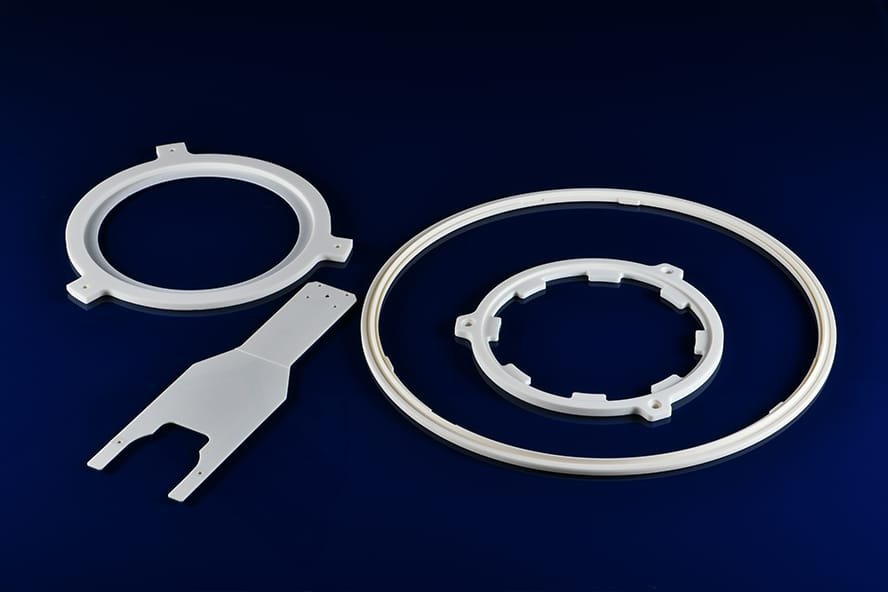Alumina Ceramic 95-99.8%
Capable of precision machining of shaped, round and curved ceramic components
As a widely used industrial ceramic, its purity ranges from 90% to over 99.8%. It is a highly durable material. The higher the purity, the better the performance. It has high hardness, wear resistance and chemical resistance. It is suitable for semiconductors, medical, automation and other fields

Alumina Advantages
- Excellent biocompatibility
- Strong electrical insulation properties
- High chemical corrosion resistance.
- Superior high-temperature stability and thermal shock resistance
- Mohs hardness up to 9, with high hardness and mechanical strength
- Capable of withstanding large mechanical loads
- Low thermal expansion coefficient and specific thermal conductivity rates
- Excellent thermal conductivity and antioxidant performance
- Wear and abrasion resistant
- Transparent to microwave radio frequencies
- High compressive and dielectric strength
Alumina Applications
- Equipment lining
- High voltage insulator
- Artificial joints, dental implants
- Igniter insulator
- Valve seals, chemical pumps
- High-temperature support structures
- Laser optical components
- Sealing rings in mechanical equipment
- Electronic components & substrates
- High-temperature electrical insulators
- High voltage insulators
- Laser tubes
- Machine components
- Mechanical seals
- Precision shafts and axles in high wear environments
- Roller and ball bearings
- Seal rings
- Semiconductor parts
- Shot blast nozzles
- Thermocouple tubes
- Tap plates
- Valve seats
- Wear components
99.8%Alumina Material Properties
Mechanical Properties
| Property | Unit | Alumina |
| Density | g/cm³ | 3.93 |
| Vickers Hardness | GPa | 18 |
| Flexural Strength | MPa | 416 |
| Compressive Strength | MPa | 2556 |
| Water Absorption Rate | % | 0 |
| Alumina Content | % | 99.8 |
| Young’s Modulus | GPa | 358 |
Thermal Performance
| Property | Unit | Alumina |
| Thermal Conductivity | W/mK | 30.8 |
| Thermal Shock Resistance Strength | J/m²·K | 2700 |
| Maximum Operating Temperature | °C | 1765 |
Electrical Characteristics
| Property | Unit | Alumina |
| Permittivity (1 MHz) | – | 9.28 |
| Electric Strength | KV/mm | 14.7 |
| Volume Resistivity | Ω·cm | 2.7×10¹⁴ |
Note: This value is for reference only and may vary slightly depending on the batch conditions.
Machining Alumina
Alumina is available in various purities, typically ranging from 90% to 99.9%, with Jundro Ceramics specializing in 99.8% purity material.
The material can be processed through several methods, including injection molding, die pressing, isostatic pressing, slip casting, and extrusionFurthermore, alumina can be effectively joined to metals or other ceramics using metalizing and brazing processes.
At Jundro Ceramics is Professional alumina ceramics manufacturer, we specialize in high-precision, complex machining Alumina parts. With our extensive in-house capabilities, including 4th and 5th axis machining centers, drilling, grinding, milling, polishing, sawing, tapping, threading, and turning, we ensure the highest quality alumina components that meet strict specifications.
5-Axis Alumina Ceramic Machining
Frequently Asked Questions
What is Alumina (Aluminum Oxide) and what are its key properties?
Alumina (Al2O3) is a highly durable technical ceramic with exceptional mechanical, electrical, and thermal properties. It boasts high hardness (Mohs hardness up to 9), wear resistance, chemical corrosion resistance, and excellent high-temperature stability, with a melting point exceeding 2050°C. Alumina is also electrically insulating, biocompatible, and offers low thermal expansion, making it suitable for applications in industries such as electronics, aerospace, and medical devices.
What are the primary industrial applications of Alumina?
Alumina is widely used across various industries due to its versatile properties. Key applications include electronic packaging substrates, microwave windows, high-voltage insulators, valve seals, chemical pumps, semiconductor components, thermocouple tubes, high-temperature structural supports, wear-resistant components, and medical implants such as artificial joints and dental crowns.
How is Alumina produced and processed?
Alumina is produced through different forming techniques, including injection molding, die pressing, isostatic pressing, slip casting, and extrusion. Following sintering, it is primarily machined using diamond grinding methods due to its hardness. Specialized techniques such as green and biscuit state machining allow for more complex geometries prior to sintering, while fully sintered alumina requires diamond-coated tools for precise final machining.
What are the different purity grades of Alumina and their respective uses?
Alumina is available in various purities, typically ranging from 90% to 99.9%. The highest-purity alumina (above 99.8%) is used in high-performance applications such as semiconductor devices, medical implants, and optical components. Lower-purity alumina (90-97%) is commonly used in industrial applications where wear resistance, electrical insulation, and corrosion resistance are required but not to the extreme precision of high-purity grades.
How is Alumina bonded to metals or other ceramics?
Alumina can be joined to metals or other ceramics using advanced techniques such as brazing, metalizing, or diffusion bonding. These methods allow for strong, reliable bonds that maintain the material’s integrity, particularly in high-temperature, high-stress environments such as in aerospace, electronics, and chemical processing equipment.
What are the machining challenges associated with Alumina and how are they addressed?
Alumina’s high hardness and toughness present challenges during machining. In its green or biscuit state, alumina is relatively easy to machine into complex shapes, but it undergoes approximately 20% shrinkage during sintering, making tight tolerances difficult to achieve. After sintering, precise machining requires the use of diamond-coated tools or grinding wheels to achieve tight tolerances, which can be a time-consuming and costly process due to the material’s inherent hardness.
